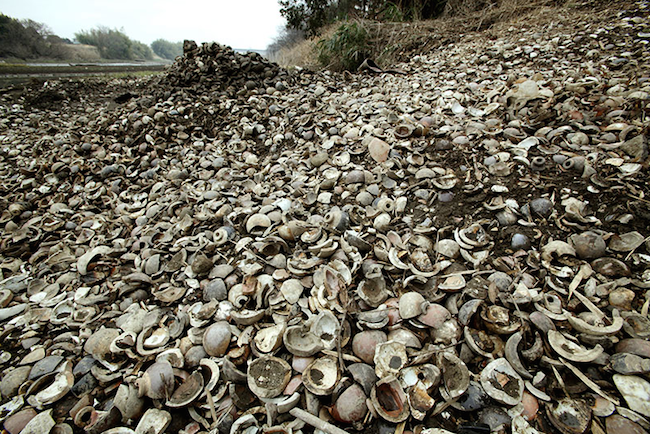Humanity hasn’t created a material yet that they haven’t at least tried killing someone with. Nowhere is that truth more plain than on the banks of a stream in Kawagoe, Japan, where shards of the short-lived ceramic “Type 4” grenade remain as a haunting reminder of the desperation of World War II.

The Asahi Shimbun recently ran a feature story about the odd stopgap weapon. Masaaki Kidachi, a professor of archeology and ceramic engineering at the Ritsumeikan University in Kyoto, told the reporter that the grenades were produced in 1944. Japan lacked the metal to produce typical grenades, so they engineered the less-deadly ceramic casings for the weapons. Similar stories are common in war; Germany melted down church bells in World War I to make more bullets when they were faced with their own metal shortage.
Like the bells, the Type 4 grenades diverted material away from art and used it for destruction. Kilns that had created traditional Japanese pottery for centuries were conscripted into the war effort to make these jury-rigged weapons. Potters who trained for years to perfect their craft found themselves making these crude-looking, thoughtless casings by the hundreds.

The waste of it is memorialized on the site of an old factory in Kawagoe. Thousands of the objects were unceremoniously dumped on the bank of a nearby stream soon after the war ended. Although the objects are considered waste and are not likely to be designated as a protected cultural property, educators and researchers with the Grass Roots House Peace Museum use the shards as an opportunity to teach.
“Yasuto Fukui, a researcher with the (Grass Roots) museum, said he makes sure that children visiting the facility touch the grenade pieces.
“’When I tell them that these ceramics look like they have nothing to do with war, but they were actually built as weapons, the children take on a serious look,” he said. “I would like them to understand the horror that these weapons were once mass-produced in their country.’”

In addition to being a sought-after curiosity for amateur war historians, the Type 4 grenade was utilized recently in an art project; the grenades were reclaimed, in a way, by the rich pottery culture they sidelined during the war.
“One ceramic producer that cooperated with Japan’s war efforts is now stressing the importance of peace through a single-flower vase resembling a ceramic grenade.
“Fujihira Pottery in Kyoto created about 300 such vases in 2006, after Tetsuo Sekimoto, professor of 3-D formation at Kyoto University of Art & Design, proposed the project.
“’I suggested the idea of turning a former weapon into a flower vase as a prayer for peace,’ Sekimoto recalled.”
Bill Rodgers is a Contributing Editor at CFile.
Any thoughts about this post? Share yours in the comment box below.


We found 4 whole ceramic hand grenades just today while looking for glass floats on the north end of Japan’s big island. One was hollow, three still had the innards. We left those alone. Wasn’t sure of the danger being unfamiliar. Awesome find if they were from WWII.
Just acquired a ceramic grenade with “Shin” stamped within a hexagon. Shin translates to fuse.
Experimental model hand grenade. Very Rare! Made of ceramic in the final days of the World War. The ersatz version – a lesser-quality design of an already used item.
Note! The item 100% INERT and it cannot be converted back into a usable item!
Shipping
We provide customers from United States with USPS Tracking number.
https://trenchartstudio.ecrater.com/p/32339421/rare-hand-ceramic-grenade-experimental
Thank you for the article and the comments, it was so interesting for me and my artistic project, thank you very much
Thank you for the article. A brown one is at the State Capital building in Missouri. The info sign said someone brought it home from the war and it was not armed.
Throughout civilization, humankind has utilized its most advanced technologies towards the betterment and beautification of its evolving, improvised world, or wielded those same technologies towards the destruction of that same world. History continues to present us with numerous examples of our repeating follies. Thank you, Bill Rodgers, for a thought provoking article and images. Dummy clay bombs were also used in training bomber crews during WWII. Is there no end to this madness, or will we eventually extinguish ourselves through outright hostilities or the resulting neglect — through the diversion of valuable human and financial resources towards more and more military spending — of our once pristine planet? We still have a vote, even in this age of the wrongheaded Citizens United decision. Be aware, be alert, and be active — use your vote wisely in the upcoming elections, perhaps the most important in our lifetimes.
Sorry for the ranting diatribe, but someone’s got to do it. There is an elephant in our teapot…
Richard Notkin
Thank you, Richard, for your thoughtful, heartfelt comments and for the ceramics you make which also promote the same important world view.
Thank you, Richard!
– Bill